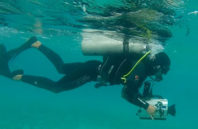Two recent studies led by OSA Member Viktor Gruev, University of Illinois (USA), have put cameras inspired by the eyes of invertebrate animals into service in very different settings. In one study, the research team used a camera based on the polarization-sensitive eyes of the mantis shrimp to develop a potential new approach to underwater geolocation. And, in the other, scientists showed that a multispectral imager based on the intricate compound eye of the blue morpho butterfly could be used to guide cancer surgery in real time.
The geolocation study relied on the “Mantis Cam,” an imager developed last year by a team including Gruev, then-grad student Missael Garcia, and several other researchers. The camera—a compact device that can record color and polarization on a single chip—is based on the complex structures in the compound eyes of the mantis shrimp, known for its polarization-sensitive, hyperspectrally tuned vision.

 (585) 768-2513
(585) 768-2513

